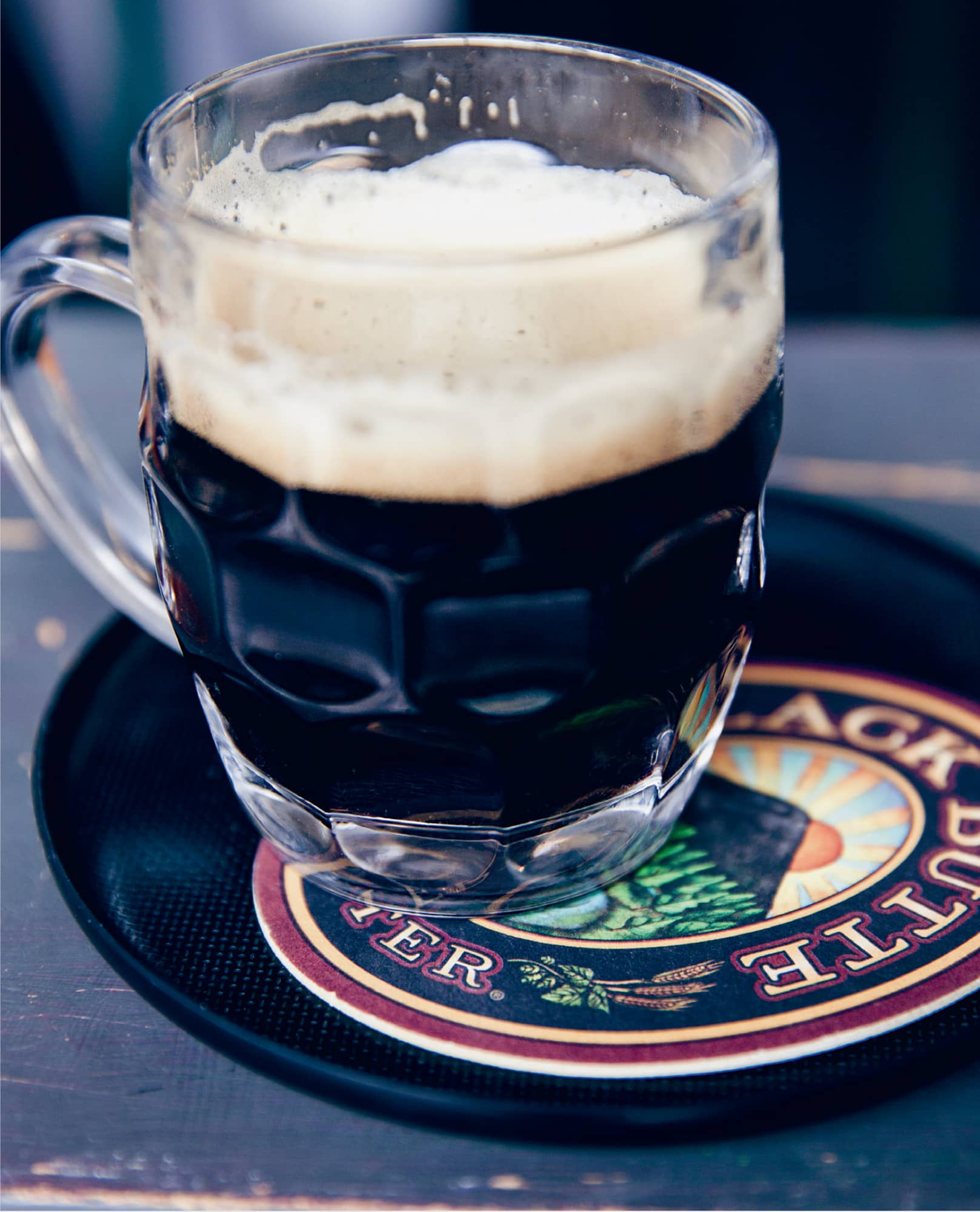Stout, porter & black

The difference between stout, porter and black IPA is a source of debate, and craft brewers love blurring the lines. Save yourself the arguments, and just make and drink them. Heavily roasted malts give a midnight-black colour and chocolate, coffee, and dark fruit notes, which stand up well to high alcohol, big hops and complementary added flavours.
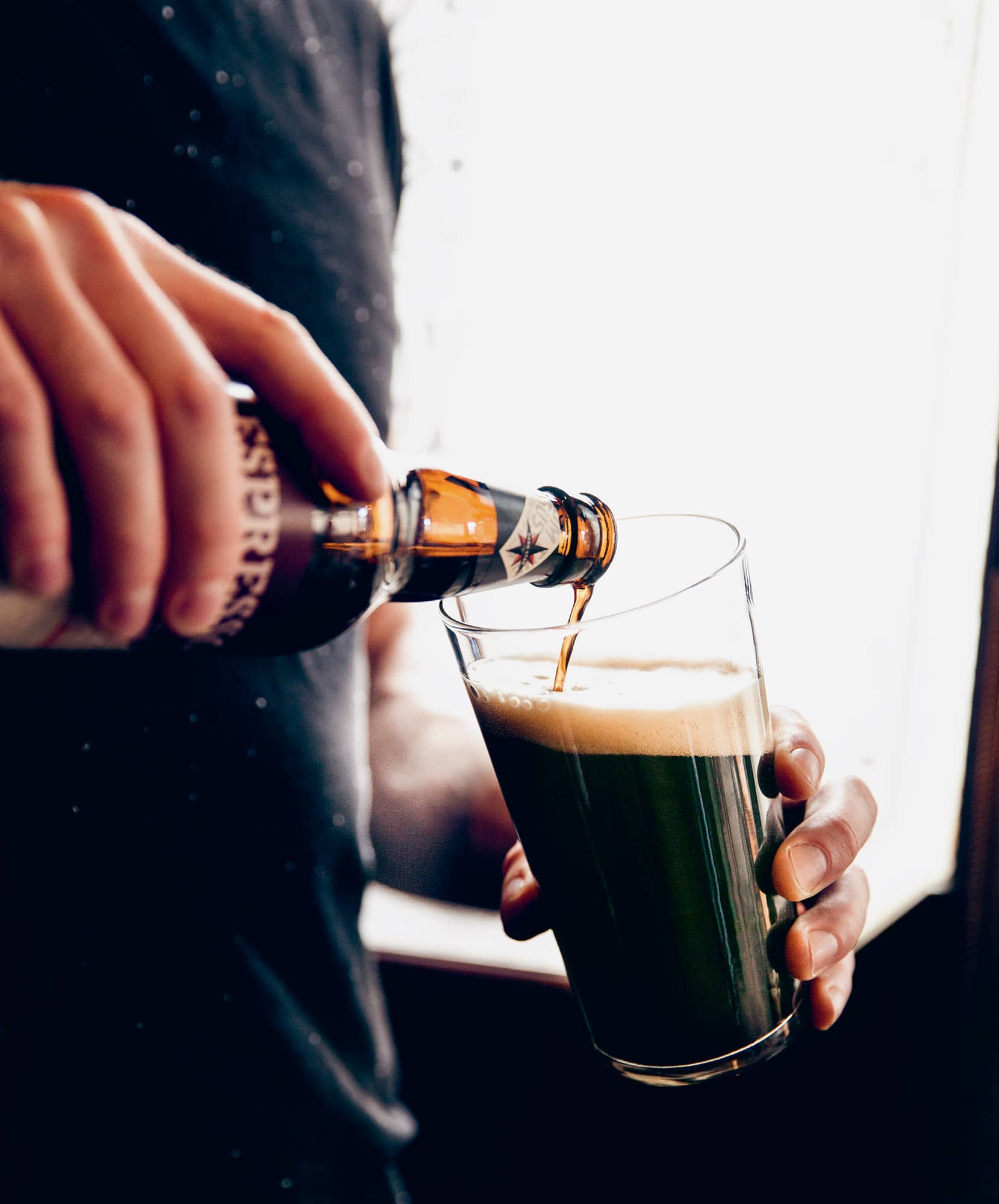
◁ Dark Star Brewing Company
West Sussex, England
ESPRESSO
DARK COFFEE BEER

20 L / 5 GAL | ABV 4.2%
OG 1.048 | FG 1.014
Reasons to love Sussex brewery Dark Star: 1) It sponsors the British National Homebrew Competition and every year brews the winning beer for commercial release. 2) It contributes to all sorts of pub and beer-related charities through the Dark Star Foundation. 3) Since 1994 it has brilliantly combined the best of British brewing traditions (plenty of cask ale) with New World ingredients and attitudes. 4) All its beer is just great, including this Espresso black beer. It’s maybe not quite hefty enough to be called a stout, as the only really dark grain involved here is the roasted barley. It’s a very useful and distinctive grain to use in heavier beers, and is highly baked in a drum, giving it almost coffee-like characteristics. Roasted barley adds a beautifully sweet aspect to cushion the bitter jolt from the ground coffee. Other coffee-based beers may use more ground beans by weight, but in Dark Star’s version it’s more of a background brew within a brew. In other words, maybe not a substitute for your morning cup of joe, but a fine beer with layers of subtle blackness.
GRAIN
Pale ale malt, 3kg/6lbs 10oz (70%)
Wheat, 690g/1lb 8oz (16%)
Roasted barley, 470g/1lb 1oz (11%)
Caramalt, 130g/4.6oz (3%)
MASH
67C/153F for 60 mins
HOPS
Challenger, 30g/1.1oz, 60 mins
Challenger, 11g/0.4oz, 0 mins
YEAST
Danstar Nottingham Ale or White Labs WLP039 Nottingham Ale
FERMENT
20C/68F
OTHER INGREDIENTS
Freshly ground Arabica coffee, the best you can get your hands on, 22g/0.8oz at the end of the boil. Leave as you would aroma hops before transferring to fermenter. Best to use a fine bag – coffee grounds are messy to clean up!
Beavertown Brewery
Tottenham, London, England

In the few short years since Beavertown Brewery was founded by Logan Plant in a London bar, it’s come a long way. Out of the basement of Duke’s Brew & Que, his barbecue restaurant, into dedicated premises in nearby Hackney Wick; then outgrowing them and moving into an even bigger space in Tottenham. And instead of just making beer for the pulled-pork-munching diners in Duke’s, Beavertown exports to twenty countries around the world from its north London base. One thing has remained the same and fuelled its expansion – a range of amazing beers unfettered by convention and founded on fearless experimentation. A few were brewed in the pub cellar and went on to form the core range (the spicy 8-Ball Rye IPA, say, or Smog Rocket); others are collaborations with some of the world’s most innovative brewers or limited-release one-offs (a bramley apple saison, for example). Some redefine ‘cult’ beer: the annual arrival of Beavertown’s 7.2% blood orange IPA is heralded by a stampede towards the bars and bottle shops lucky enough to have some in stock. There’s also a canning line for the core beers: a commitment to freshness and lower environmental impact. And central to the Beavertown success is the identity, which has been clear since the start. Nick Dwyer worked in Duke’s and presented Logan with a few sketches inspired by his brews: “If you ever need labels for them, here are some ideas.” Now Nick is the brewery’s creative director and his much-lauded designs are seen on cans by eager Beaver lovers in markets as diverse as Australia, the US and Hong Kong.
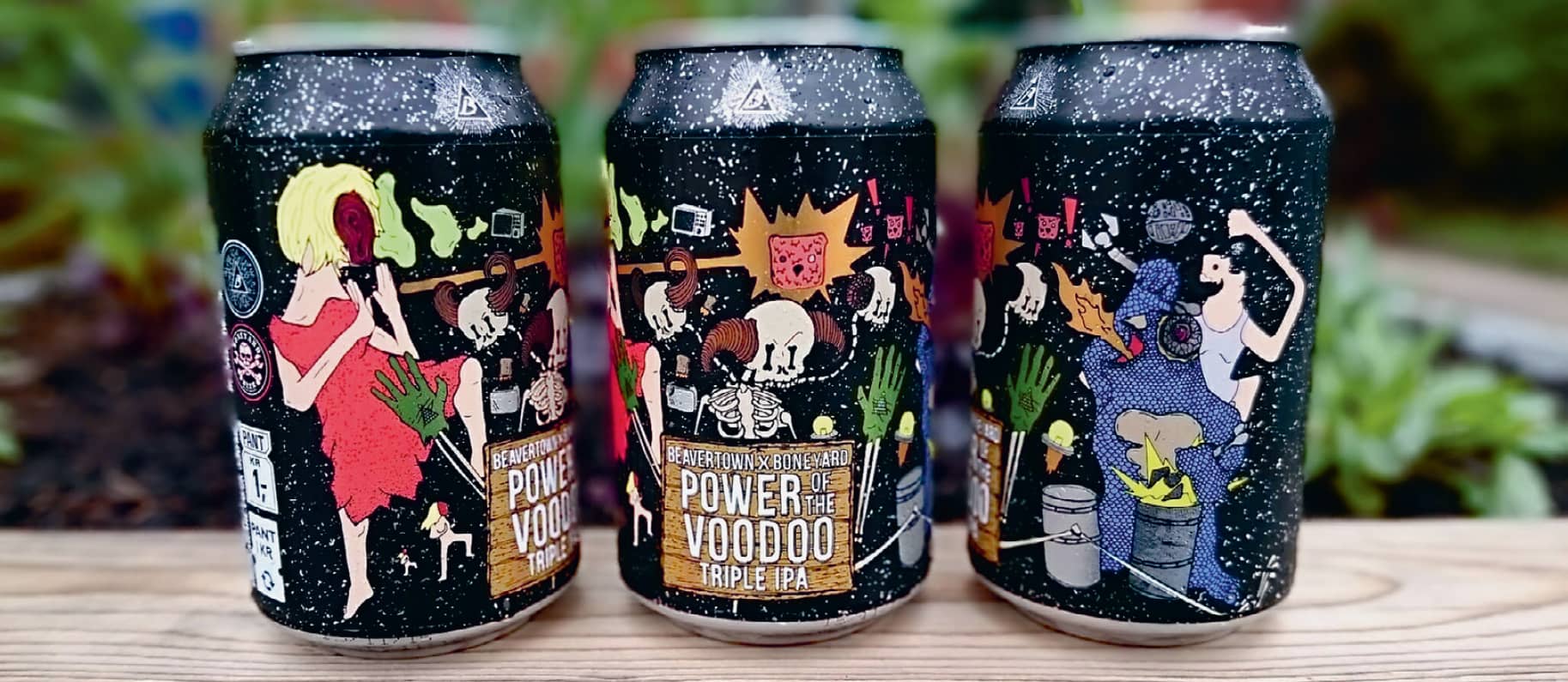
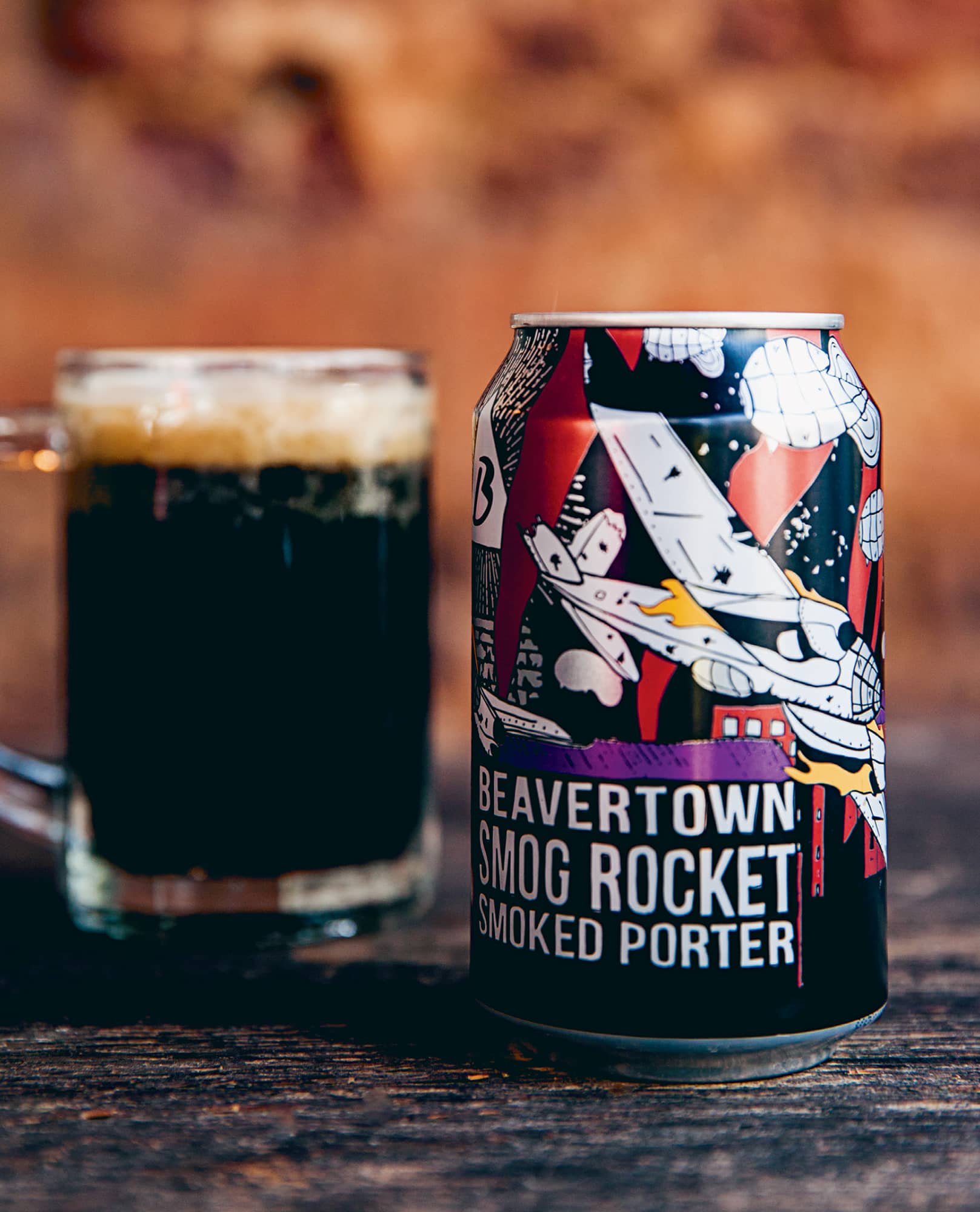
◁ Beavertown Brewery
Tottenham, London, England
SMOG ROCKET
SMOKED PORTER

20 L / 5 GAL | ABV 5.4%
OG 1.057 | FG 1.014
This is one of Beavertown founder Logan Plant’s original homebrew recipes, and it has survived the journey from kitchen kit to 50 hectolitres pretty much intact. Smog Rocket’s hugely diverse grain bill – nine varieties! – creates a complex and involving porter, with an enveloping darkness that allows the smoke to curl in and out among the roasted coffee, burnt toffee, smouldering peat and dark chocolate flavours. Too much smokiness in any brew recipe could lead to an overpowering ashtray sensation rather than a gently welcoming wisp of campfire, but the proportion of smoked malt here is carefully balanced by its mash mates. The combination of crystal, brown, chocolate, cara and black, even in low quantities, all bring something unique to the mix. Hops in this beer are there mainly for equilibrium (the IBUs are fairly low), although the delicately smoky notes sometimes picked up in Chinook make themselves known too. Beavertown cans almost its whole range and they’re available around the world now, so if you see a Smog Rocket, snap it up.
GRAIN
Pale malt, 1.53kg/3lbs 5.6oz (30%)
Beechwood-smoked malt, 1.53kg/3lbs 5.6oz (30%)
Munich malt, 560g/1lb 3.75oz (11%)
Flaked oats, 410g/14.5oz (8%)
Dark crystal malt, 310g/ 10.9oz (6%)
Brown malt, 310g/10.9oz (6%)
Chocolate malt, 310g/10.9oz (6%)
Caramalt, 100g/3.5oz (2%)
Black malt, 50g/1.8oz (1%)
MASH
66C/150F for 60 mins
HOPS
Magnum, 8g/0.3oz, 60 mins
Chinook, 14g/0.5oz, 30 mins
YEAST
Fermentis US-05 American Ale
FERMENT
19C/66F
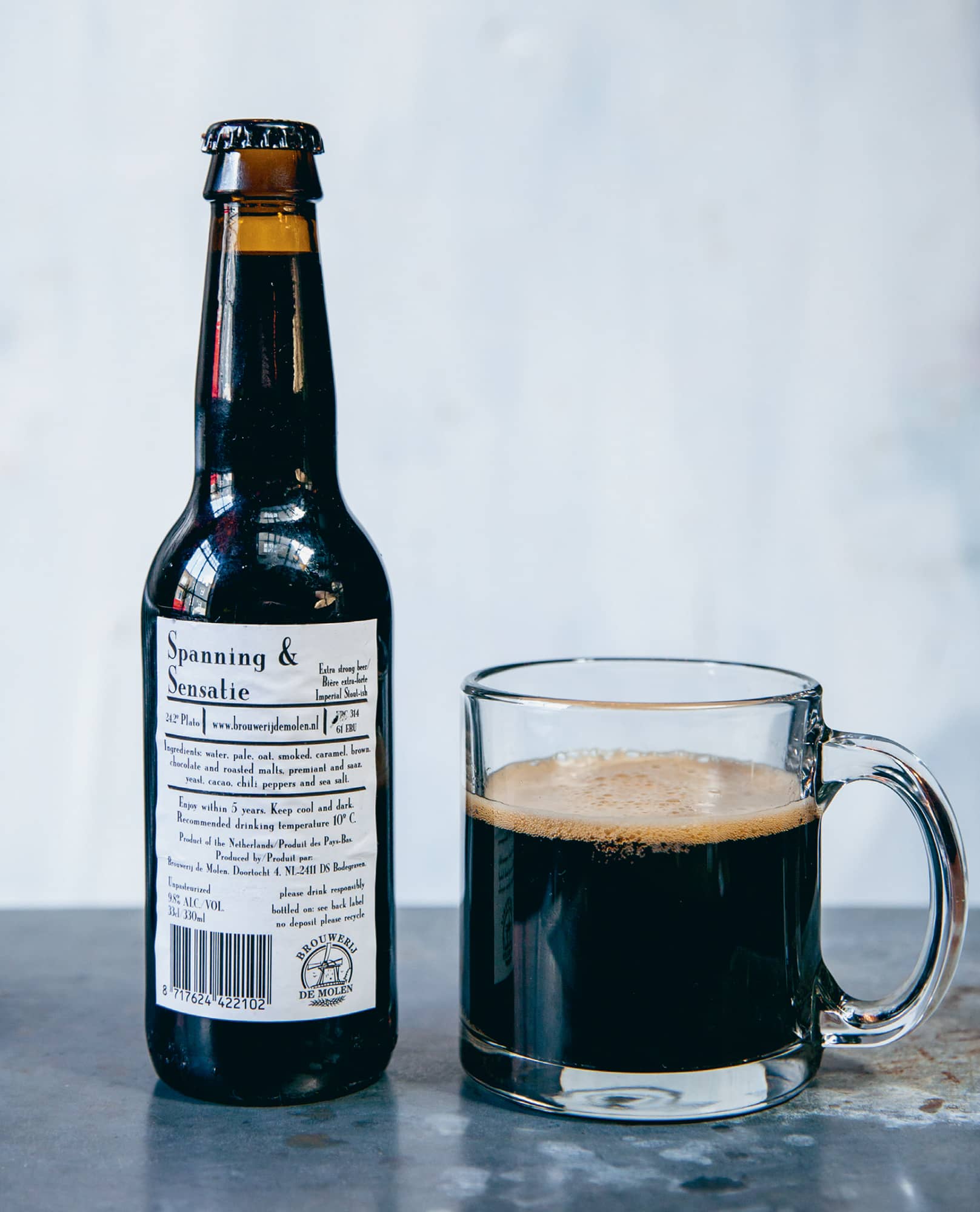
◁ Brouwerij de Molen
Bodegraven, Netherlands
SPANNING & SENSATIE
SPICED IMPERIAL STOUT

20 L / 5 GAL | ABV 9.8%
OG 1.102 | FG 1.028
The brewing of the Netherlands might be historically overshadowed by its neighbours Belgium and Germany, but under these conditions a microbrewing industry thrives, free from any need to even pretend to compete with the likes of Heineken. De Molen (‘the Windmill’) is the most consistently eclectic, bold and brilliant, notable not just in Holland but across the world for an enormous roster of rarely repeated beers with inspiration from classic European and US styles. Spanning & Sensatie (‘Thrills & Spills’) is described as ‘Imperial Stout-ish’, and it’s certainly strong, panther-black and loaded with roasted malts; such turbo-charged porters are never short of flavour, but this is enhanced daringly with cacao nibs, chilli and salt. The result is something like a molten Aztec dark chocolate bar, with liquorice and coffee undertones, a warming current of alcohol and spice and an intriguing tang at the end. However, the additions are nothing without a good beer, and imperial stout isn’t easy to brew, so take your time: vorlauf slowly, sparge slowly, run off slowly, pitch yeast heavily, then age… slowly.
GRAIN
Belgian pilsner malt, 4.03kg/ 8lbs 14oz (43%)
Smoked malt, 1.22kg/2lbs 11oz (13%)
Brown malt, 940g/2lbs 1oz (10%)
Crystal malt 60L, 940g/2lb 1oz (10%)
Flaked oats, 840g/1lb 13.6oz (9%)
Acid malt, 750g/1lb 10.5oz (8%)
Chocolate malt, 520g/1lb 2.3oz (5.5%)
Roasted barley, 140g/4.9oz (1.5%)
MASH
69C/156F for 60 mins
HOPS
Columbus, 60g/2.1oz, 90 mins
Saaz, 8g/0.3oz, 10 mins
YEAST
Fermentis US-05 American Ale, 2 packs
OTHER INGREDIENTS
Cacao nibs, crushed lightly, 100g/3.5oz
1/2 Madame Jeanette chilli pepper
Sea salt, 10g/0.35oz
Put all in a sanitised bag and add after primary fermentation for up to a week
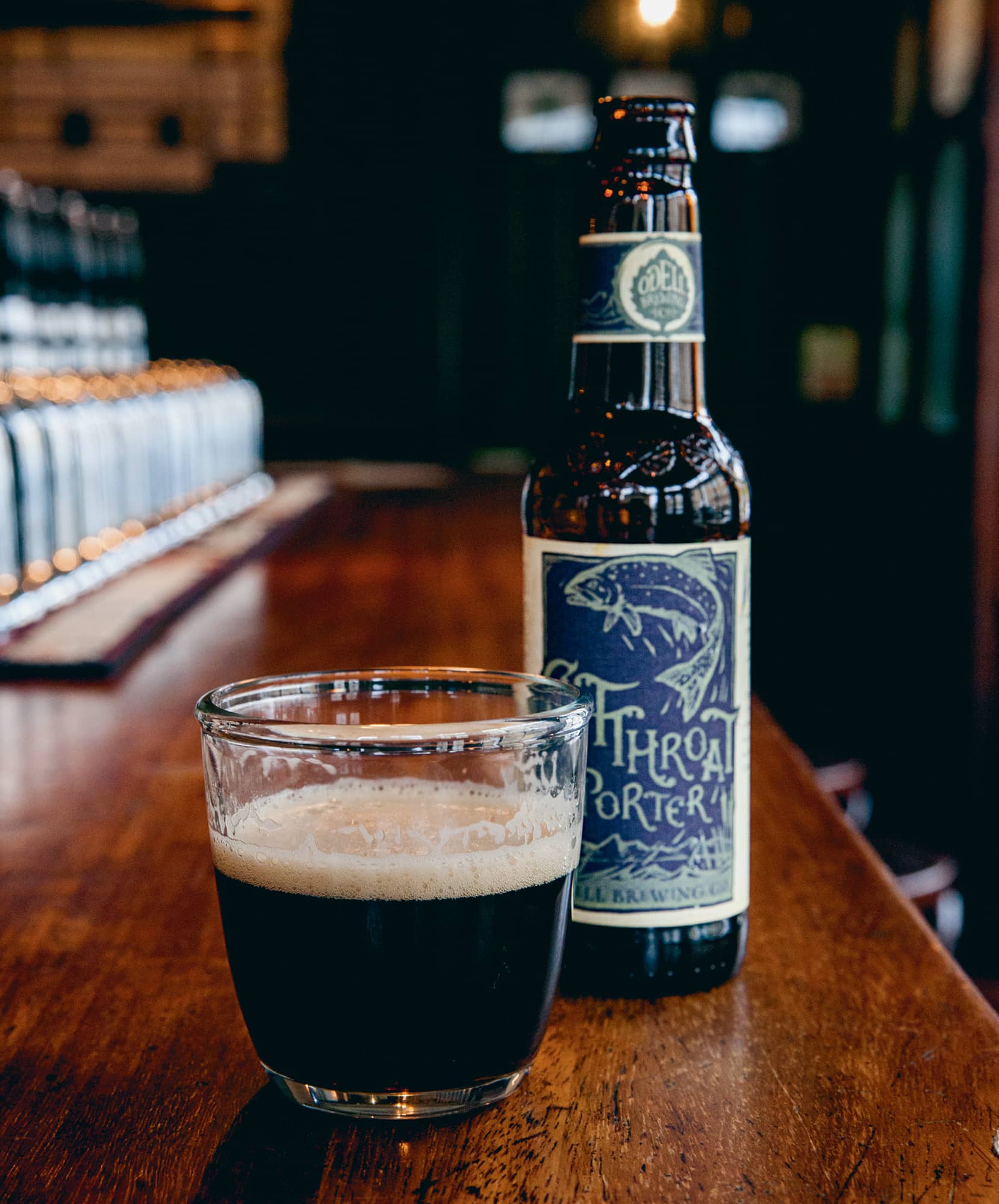
◁ Odell Brewing Company
Fort Collins, Colorado, USA
CUTTHROAT PORTER
PORTER

20 L / 5 GAL | ABV 5.1%
OG 1.050 | FG 1.015
Doug Odell was making beer at home back when most of today’s craft brewers were drinking nothing stronger than milk. Now he’s one of the most respected brewers in the country, and his canny expansion from Colorado across the world is based on a foundation of great beer with a perfect balance between experimentation and consistency. His take on a 90/- Scottish ale has been an Odell constant since 1989 and is a modern classic; so too this creamy Cutthroat Porter, named after an endangered Coloradan trout. Technically speaking, it’s more of a ‘brown’ than a robust porter, having a lower percentage of the highest-roast malts than some other examples. The mash temperature is high to create a full body in the beer, and the English ale yeast is low in esters and clean, but leaves a mild sweetness that suits the style. It’s deep and dark, with plenty of coffee, chocolate, tobacco and burnt flavours; this, along with its English East Kent Goldings and Fuggles at flameout (hops are meant to be subtle in this style) plus easygoing ABV, makes it an accessible and sessionable porter.
GRAIN
Pale ale malt, 3.78kg/8lbs 5.3oz (79%)
Caramalt, 270g/9.5oz (5.5%)
Chocolate malt, 220g/ 7.8oz (4.5%)
Crystal malt 53-60L, 170g/6oz (3.5%)
Amber malt, 170g/6oz (3.5%)
Munich malt, 110g/3.9oz (2.5%)
Roasted barley, 60g/1.8oz (1.5%)
MASH
68C/154F for 60 mins
HOPS
Nugget, Cascade or any good bittering hop, 24g/0.85oz, 60 mins, to hit 40 IBUs
East Kent Goldings, 12g/0/4oz, 0 minutes
Fuggles, 10g/0.35oz, 0 minutes
YEAST
A clean, low-ester yeast, such as WLP002 English Ale
FERMENT
20C/68F
◁ Deschutes Brewery
Bend, Oregon, USA
BLACK BUTTE PORTER
PORTER

20 L / 5 GAL | ABV 5.2%
OG 1.057 | FG 1.019
Deschutes is a beacon of righteous Oregon brewing. Named after the local river, it’s been based in Bend since 1988, when it opened as a humble brewpub. Bend is a town surrounded by place names familiar to brewers the world over thanks to the state’s famous hops, including the Cascade Mountains and Willamette National Forest; Deschutes is now one of the biggest craft breweries in USA. Forming a solid base to a series of experimentals and seasonals (including the much-anticipated fresh-hopped IPA in winter) is a core range that includes this Black Butte Porter, a tribute to an extinct volcano in Deschutes National Forest. For a long-established Pacific Northwestern brewery to have a porter as its flagship brew is brave, but this rich, sweet and creamy beer is every bit as drinkable as a pale ale. Bravo is a fairly new (2006) hop from local breeding fields which brings high alpha acid levels and a lightly fruity aroma; it’s augmented with the most-used craft hop variety in the US (Cascade) plus Tettnang. A weeknight porter with enough character to see you through to Saturday.
GRAIN
2-row pale malt, 2.8kg/ 6lbs 2.8oz (63%)
Chocolate malt, 450g/1lb (10%)
Wheat malt, 400g/14oz (9%)
Crystal malt C75, 400g/14oz (9%)
Carapils, 400g/14oz (9%)
MASH
Mash in at 54C/130F and hold for 10 mins. Raise temperature to 69C/157F and rest for 30 mins. Mash off at 75C/168F and hold for at least 5 mins
HOPS
Bravo 14% AA, 14g/0.5oz, 60 mins
Cascade 6% AA, 14g/0.5oz, 30 mins
Tettnang 5% AA, 28g/1oz, 5 mins
YEAST
White Labs WLP002 English Ale or Wyeast 1187 Ringwood Ale
FERMENT
17C/63F
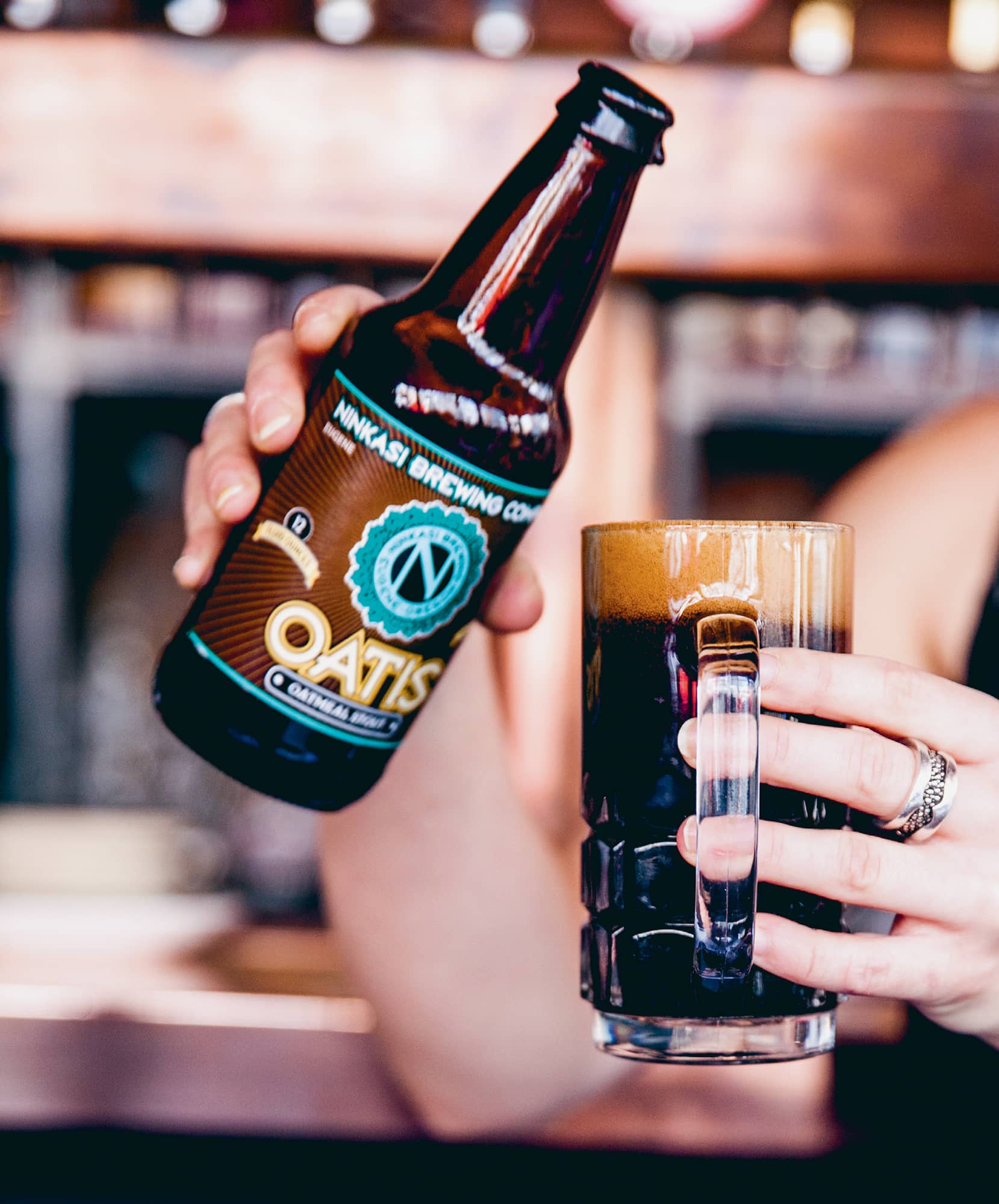
◁ Ninkasi Brewing Company
Eugene, Oregon, USA
OATIS
OATMEAL STOUT

20 L / 5 GAL | ABV 7%
OG 1.072 | FG 1.020
Oregon is a pretty good place to be a craft beer fan, as you can tell from the dozens of breweries dedicated to keeping the Beaver State flush with good things to drink. And although Portland may have more breweries per head, Eugene is a pretty good city to be a craft beer fan too. As well as Ninkasi, beermakers here include Hop Valley, whose cans burst with the flavours of the region’s precious hop crop, as well as Oakshire and a whole load more. Ninkasi is a refreshing alternative to the skulls-and-heavy-metal-asskicking that typifies a lot of brewing: it’s named after the Sumerian goddess of beer, its ‘Beer is Love’ programme supports charity in a big way, its spent grain goes to feed some (lucky) naturally reared cows. And it makes fine beer: Oatis is a tribute to the brewery’s mascot dog Otis, and while he might not be able to enjoy it, the rest of us can appreciate the silky smooth mouthfeel, the deep dark roastiness and the balance of sweet malt and mildly bitter Nugget hops. Ninkasi also makes a Vanilla Oatis, which has an extra creamy depth.
GRAIN
2-row pale malt, 4.86kg/10lbs 11.4oz (74%)
Chocolate malt, 390g/13.8oz (6%)
Crystal malt, 390g/13.8oz (6%)
Flaked oats, 390g/13.8oz (6%)
Vienna malt, 330g/11.6oz (5%)
Roasted barley, 130g/4.6oz (2%)
Rice hulls, 70g/2.5oz (1%)
MASH
67C/152F for 40 mins
HOPS
Nugget, 23g/0.8oz, 60 mins
Nugget, 23g/0.8 oz, 30 mins
YEAST
White Labs WLP005 British Ale
FERMENT
20C/68F for 3-7 days; hold for 2 days at final gravity; chill to 0C/32F for 7-10 days
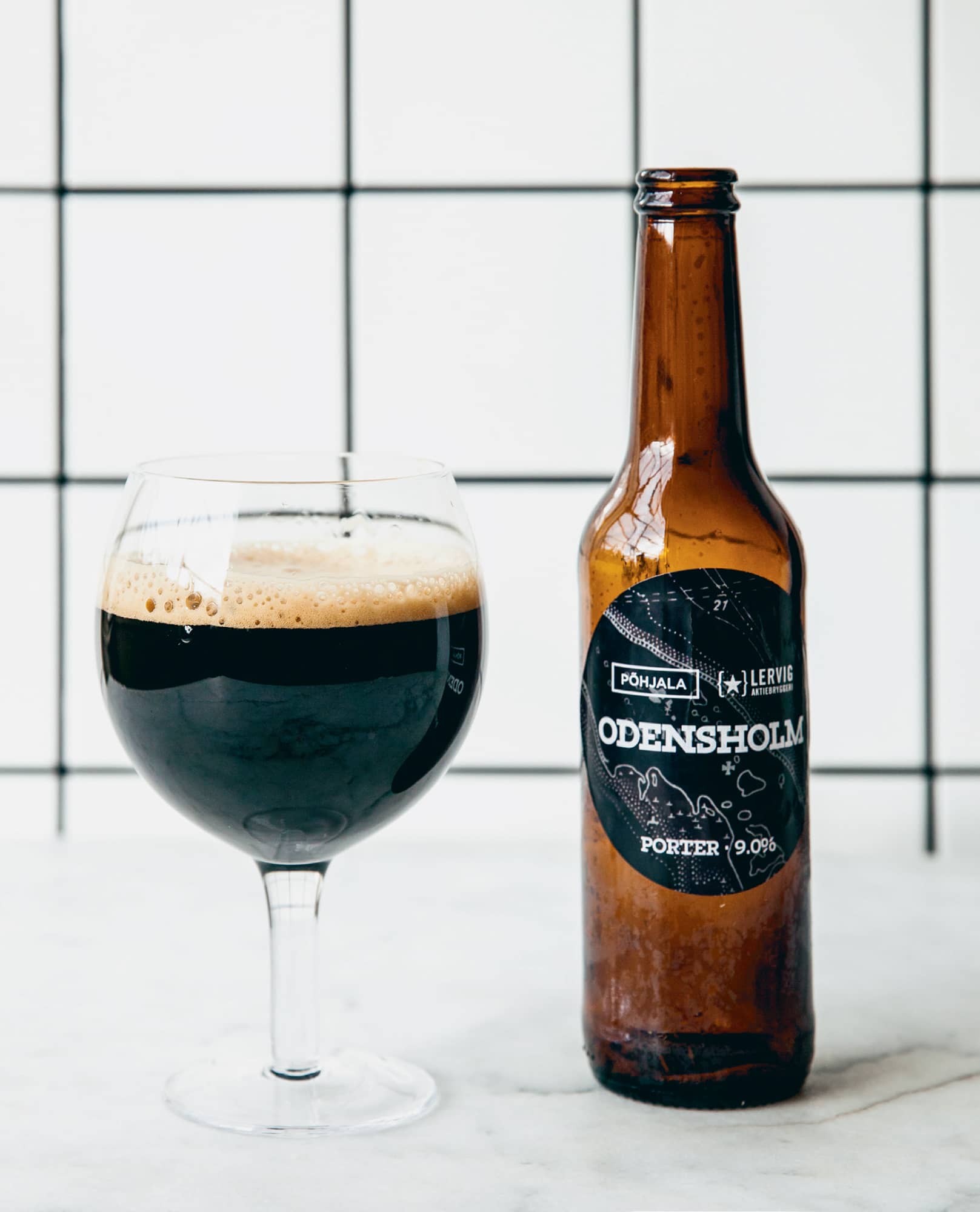
◁ Põhjala
Tallin, Estonia
ODENSHOLM
IMPERIAL PORTER

20 L / 5 GAL | ABV 9%
OG 1.083 | FG 1.019
For most people outside the country, Estonian beer means Viru, a pilsner whose unusual tower-shaped bottle somewhat overshadows its contents in terms of interest. Not now: there’s a real craft scene, with young breweries across the Eastern European state producing memorable beers. Põhjala is based in the capital Tallinn and headed up by Christopher Pilkington, a Scottish brewer once of Brewdog. Põhjala teamed up with another northern powerhouse, Norway’s Lervig, to create this midwinter-black imperial porter. Such supercharged stouts are often described in terms of ‘size’, and this one’s so big it has dark corners to get lost in. The rye and chocolate rye give it a spicy kick, while the long maturation at low temperature take the warming alcohol and bitter hops into deep new dimensions. Make sure your yeast is healthy – it will have a lot of work to do. Christopher gives his beer a further rest in a pinot noir barrel, which if you can do you should: “It makes the dark berry flavours of the carafa malt and chocolate rye merge perfectly.” One to get you through a cold night.
GRAIN
Viking pale malt, 4.84kg/ 10lb 10.7oz (62.5%)
Rye malt, 1.55kg/3lb 6.7oz (20%)
Carafa Special Type-II malt, 500g/1lb 1.6oz (6.5%)
Chocolate rye malt, 390g/13.8oz (5%)
Special B malt, 390g/13.8oz (5%)
MASH
68C/154F for 45 mins
HOPS
Magnum or CTZ, 50g/1.76oz, 60 mins
Chinook, 20g/0.7oz, 0 mins
YEAST
White Labs WLP090 San Diego Super
FERMENT
19C/66F, then 4 weeks maturation at 0C/32F
OTHER INGREDIENTS
Demerara sugar, 80g/2.8oz (1%), halfway through boil
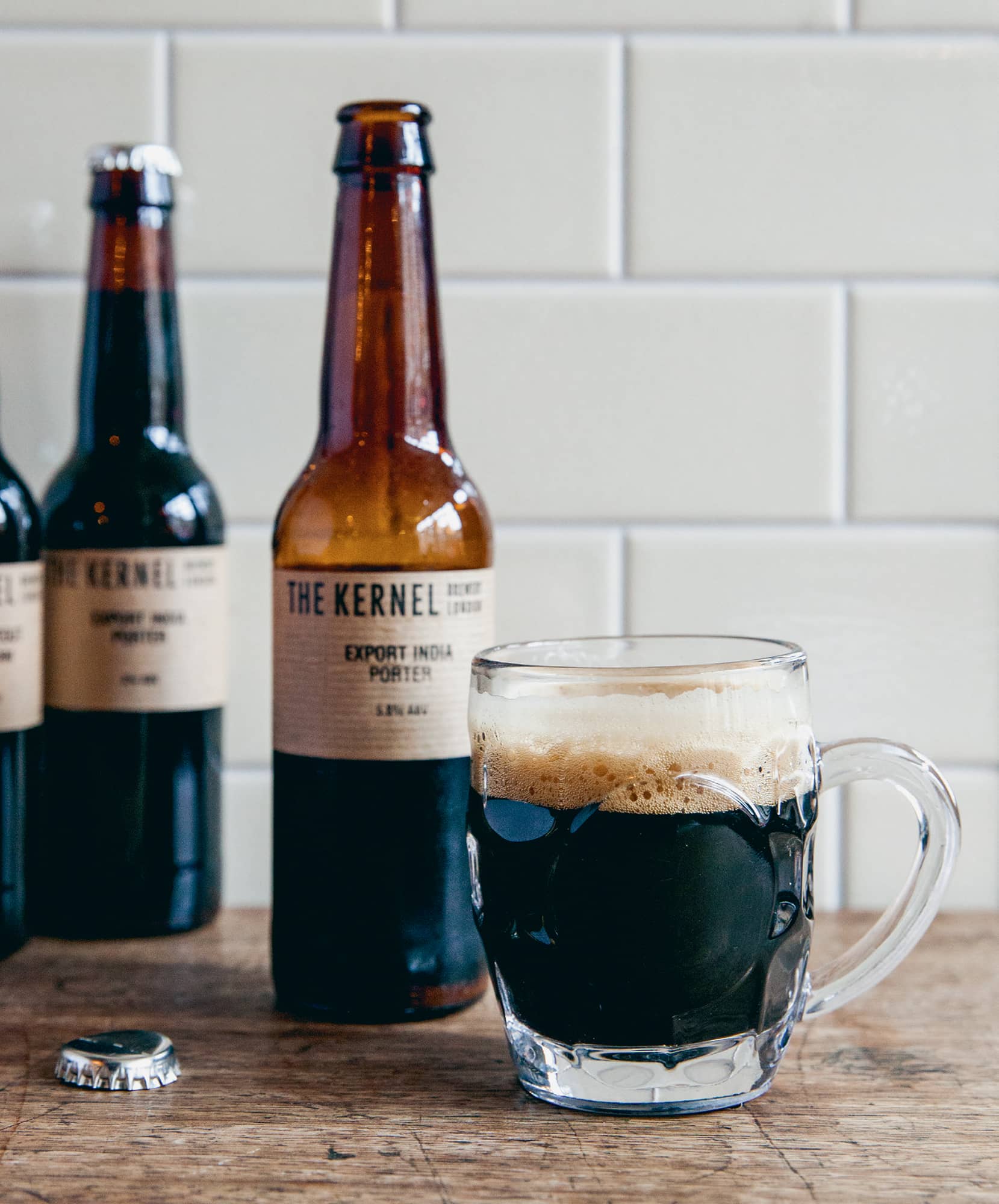
◁ The Kernel Brewery
Bermondsey, London, England
EXPORT INDIA PORTER
EXPORT INDIA PORTER

20 L / 5 GAL | ABV 6%
OG 1.060 | FG 1.016
This is not subjective, it’s true: the Kernel makes incredible beer. Everything about it speaks of simplicity: brown hand-printed labels with minimal information (no tasting notes or boasts of how the contents will change your life); a concise range of beers, ever changing but always true to their style and perfectly crafted. They’re mainly heartily hopped IPAs and pale ales, plus the easy-drinking Table Beer, sours and reinventions of historical London styles like mighty stouts and porters. This Export India Porter is free with the hops, just as they would have been in the nineteenth century. And the varieties aren’t specified. That’s not secrecy, it’s because there are no fixed recipes. “We like to experiment with different hop varieties,” says founder Evin O’Riordain. “They can create very different flavours when combined with darker malts, which is fascinating. Bramling Cross is our favourite for a more traditional British character. Columbus works very well for a brasher, New World character.” Use the recipe here as an inspiration, aim for about 48 IBU. The Kernel uses hard London water, with extra calcium chloride.
GRAIN
Maris Otter malt, 3.96kg/ 8lbs 11.7oz (75.5%)
Brown malt, 370g/13oz (7%)
Chocolate malt, 370g/13oz (7%)
Dark crystal malt, 370g/13oz (7%)
Black malt, 180g/6.3oz (3.5%)
MASH
Around 69C/156F for 60 mins
HOPS
12% AA, 10g/0.35oz, first wort hop
12% AA, 10g/0.35oz, 15 mins
12% AA, 14g/0.5oz, 10 minutes
12% AA, 20g/0.7oz, 5 minutes
12% AA, 40g/1.4oz, dry hop for 3 days before bottling/kegging
YEAST
Kernel uses a house yeast, but you could use something locally appropriate like White Labs WLP013 London Ale
FERMENT
20C/68F, then condition for 10-14 days at 15-20C/59-68F for the beer to carbonate properly
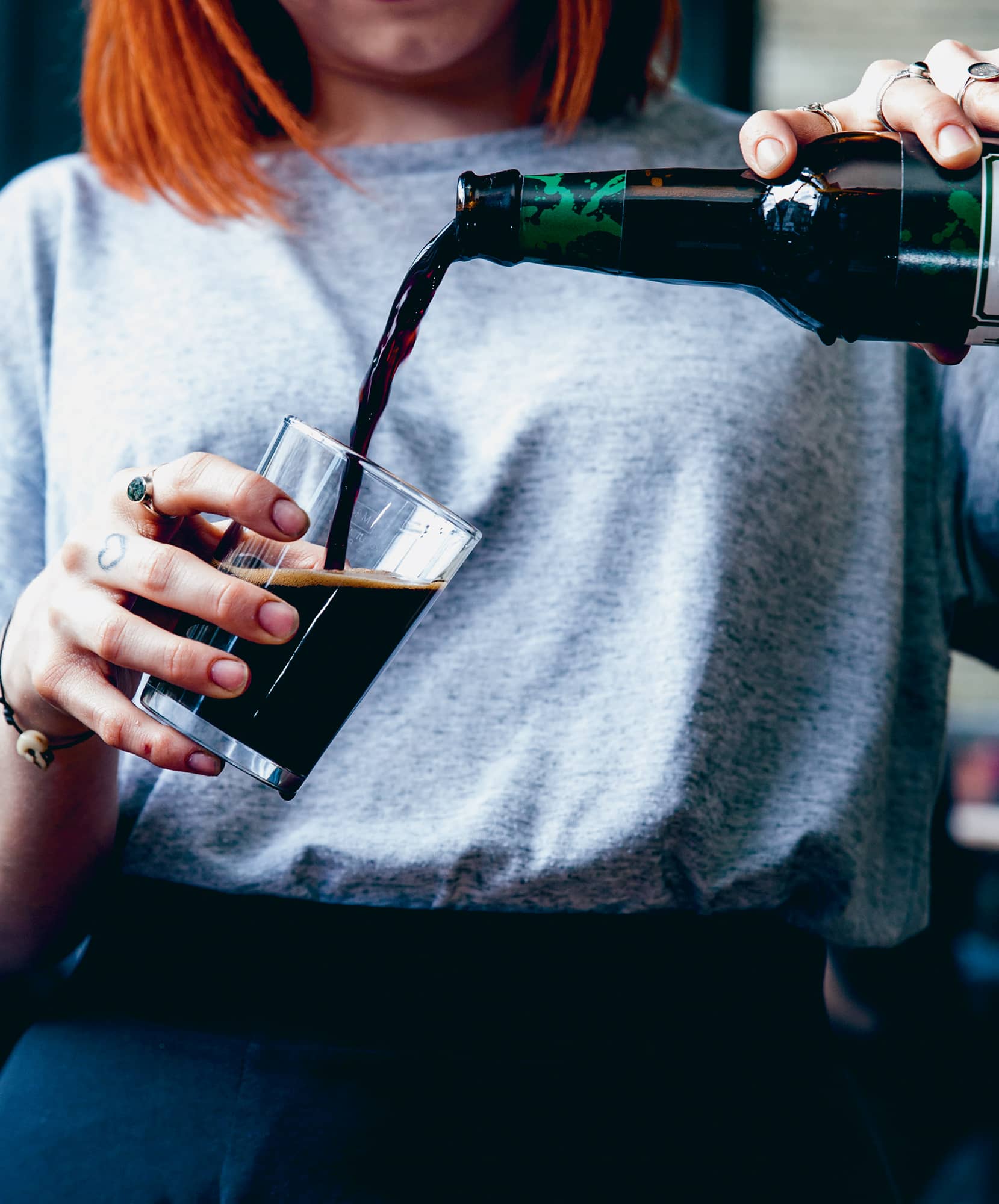
◁ To Øl
Copenhagen, Denmark
BLACK BALL
PORTER

20 L / 5 GAL | ABV 7.1%
OG 1.084 | FG 1.024
Non-Danish speakers – it’s pronounced ‘too eul’ and translates into one of the best phrases in any language: ‘two beers’. In 2005, founders Tobias and Tore, then at school, had a cool science teacher who just happened to be future Mikkeller supremo Mikkel Borg Bjergsø (see here). United by a disillusion with mainstream Danish beer (you surely know which one), the trio began brewing in the school kitchen after hours. The school was presumably totally fine with this arrangement, and it’s worked out pretty well for beer lovers too. If you were ever in any doubt that Denmark is probably the best place to live in the world, that story has doubtless convinced you. In the progressive way, To Øl has no premises – it’s a gypsy brewery – but still manages to make an increasingly adventurous range of beautifully designed beers. And this Black Ball is no ordinary porter: the multifarious malt bill is nuanced and involving, the unrefined sugar adds further intrigue, and the plentiful hops illuminate the dark depths. Hoppy porter, black IPA or India stout? When it tastes this good, who cares.
GRAIN
Pilsner malt, 4.15kg/9lbs 2.4oz (57%)
Roasted barley, 700g/1lb 8.7oz (9.5%)
Smoked malt, 610g/1lb 5.5oz (8%)
Flaked oats, 530g/1lb 2.7oz (7%)
Chocolate malt, 440g/15.5oz (6%)
Caramunich, 350g/12.4oz (5%)
Brown malt, 210g/7.4oz (3%)
MASH
67C/152F for 60 mins, 72C/ 161F for 15 mins
HOPS
Simcoe 13% AA, 26g/0.9oz, 60 mins
Simcoe 13% AA, 20g/0.7oz, 15 mins
Centennial 10% AA, 20g/0.7oz, 10 mins
Cascade 6.5%AA, 30g/1oz, 1 min
YEAST
White Labs WLP002 English Ale
FERMENT
20-21C/68-70F
OTHER INGREDIENTS
Demerera, cassonade or similar dark sugar, 210g/7.4oz (4.5%), added at mash stage

